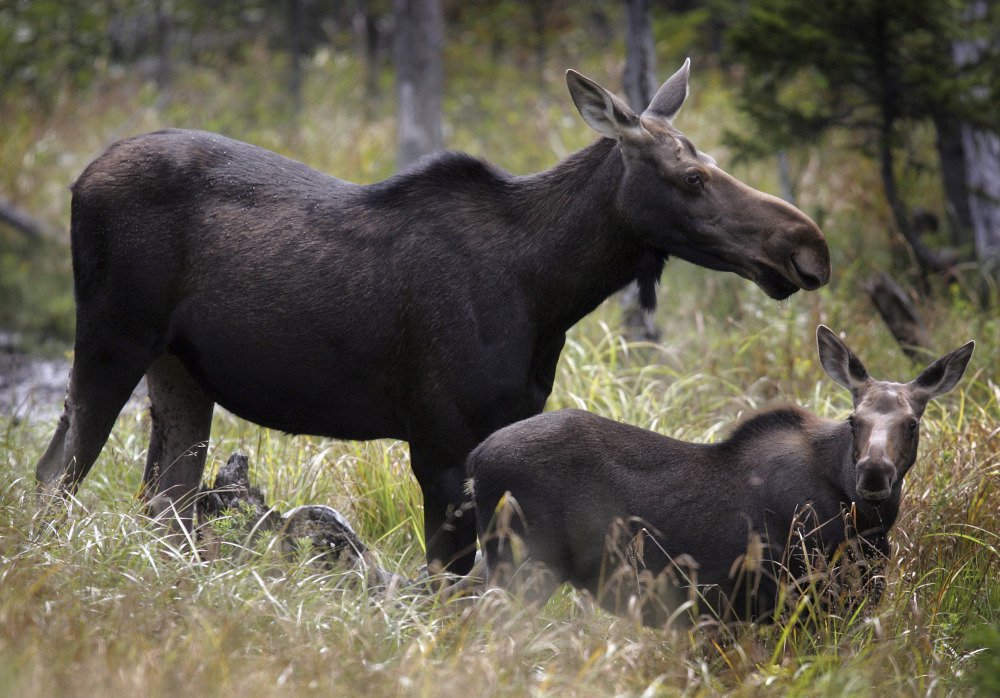CONCORD, N.H. – Last year’s drought in New Hampshire was tough on farmers and towns. But, it turns out, it was good for moose.
Preliminary numbers from a project that puts tracking collars on moose show that only one of the calves – the most vulnerable group – died from winter ticks this year. A year ago, nearly 75 percent of the calves tracked died.
Project leaders are still watching with caution, as winter ticks are in the adult stage in April and are feeding heavily. But moose biologist Kristine Rines said the tick count was down on moose collared in January; many of the blood-sucking parasites died because they were deprived of moisture.
Still, the ticks have a long-term advantage, with shorter winters and moose density on their side. If you add regular drought to the picture, “maybe the ticks will naturally die down a bit, but they’re not going to go away, unfortunately,” she said.
The latest findings come as a state commission prepares to vote Wednesday on a proposed 51 permits for the annual moose hunt, the lowest in nearly 30 years. It was 71 last year. Permits have declined, partly because of the impact of ticks and brainworm on moose. Permits also are down to 80 in Vermont, from 165 last year. Maine authorities want to cut the number of moose permits to 2,080, 60 less than last year. The states are part of a moose mortality study that tags and follows the animals.
Maine doesn’t have calf data for this year, yet. Vermont, which joined the study this year and didn’t have drought issues as serious as New Hampshire, has seen five of its 30 collared calves die, so far.
Many residents are concerned about the future of moose, but they disagree on what to do about it. Some, including the New Hampshire Wildlife Federation, which represents more than 15,000 hunters, fishers and trappers, say they support fewer hunting permits. The wildlife federation says it understands the Fish and Game Department’s goals to maintain a healthy moose population, as well as the challenges of trying to reopen a hunting season once it is stopped.
“Because of these challenges, we strongly urge the department to continue with a moose season, no matter how limited, and not cancel the season outright,” group vice president Bob Dufresne said in a letter on the proposal.
Others feel the permits should be suspended for a while to figure out a solution and let the moose population grow. Some feel it’s time to stop moose hunting, period.
“One of New Hampshire’s most treasured natural attractions and important to tourism, the moose population is already threatened,” Pam Cote of Gilford wrote to the department. “Why would you threaten it further?”
Moose population densities are taken into account in all hunting areas. Some permits have been lowered and others suspended because the number of moose fall below management goals.
“We continue to take a very conservative approach given recent regional and national trends of moose populations and health,” said wildlife biologist Cedric Alexander, Vermont’s moose project leader. “Moose biologists from the southern tier of moose range across North America are increasingly concerned about the effects of warming temperatures on moose health. Moose can easily become stressed by warmer weather, causing them to feed less, and early spring snow melt that results in higher winter tick loads the following year.”
In New Hampshire, there were only about 50 moose in 1950. That number had grown to 4,100 by 1988, when the state started an annual hunt and issued 75 permits. Today, it has about 3,600 moose.
Rines notes the hunt is targeting about 1 percent of the moose population in New Hampshire. She said parasites are the bigger problem, and will continue to be so in the future.
“We’re killing what will be four times as many animals by cars as we will kill in a hunt,” she said. “Is anyone going to recommend we stop driving? That will have a bigger impact. … We could stop (hunting) tomorrow, and what’s going to happen to these animals will continue to happen.”
Send questions/comments to the editors.


